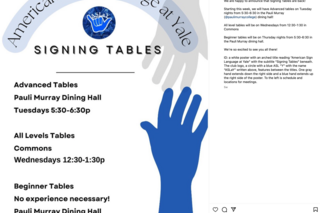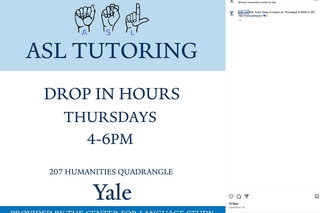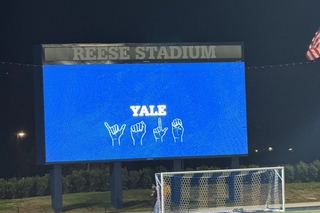Come explore the beauty of American Sign Language at Yale University, where language learning transcends the classroom!
Yale’s ASL program immerses students in the expressive world of Deaf culture, offering a comprehensive curriculum that covers everything from foundational sign language skills to advanced Deaf studies. Guided by passionate, expert instructors, students engage in interactive, hands-on learning experiences that bring the language to life. Whether you’re aiming to become fluent in ASL, enhance your career prospects, or broaden your cultural horizons, Yale provides a welcoming and stimulating environment. Dive into the dynamic intersection of language and culture, and join a community dedicated to promoting communication, inclusion, and understanding. At Yale, ASL is more than a language—it’s a gateway to a richer, more connected world.
Meet the ASL Lectors
-

-
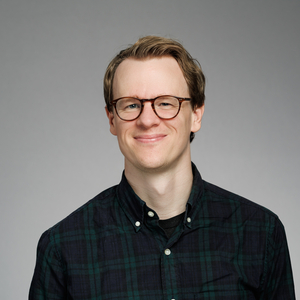
-
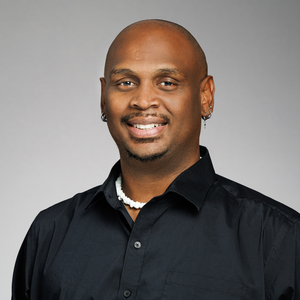
-
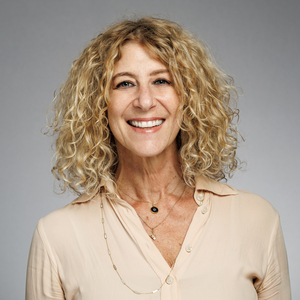
-
American Sign Language
Julia Silvestri
Program Director & Senior Lector 1Associate Research Scholar in Linguistics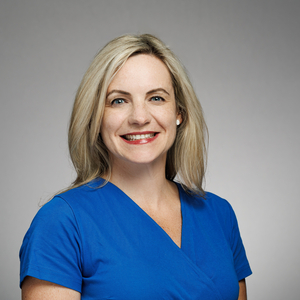
-
Our curriculum and program placement
For more information on curriculum and placement procedures, visit our program page or contact us directly.
-
American Sign Language now Yale’s third most popular language
In the spring of 2018, when American Sign Language was first offered at Yale, 20 students registered for the course. This fall, there are 257 students
Get Involved
Yale’s ASL program is more than just a series of courses; it’s a vibrant community, and a way to connect and enrich your understanding of the world.
Students have the opportunity to participate in various activities such as ASL variety shows, open houses, cultural events, and workshops. We also offer internships, tutoring, and mentoring programs to enhance real-world experience and professional development.
-
ASLAY Instagram
Join us at our signing tables. No experience necessary and all are welcome!
-
Yale ASL Program
ASL tutoring, drop in hours, and other events on instagram.
-
Find us on campus
ASL Soccer Day was a fantastic success! 🤟⚽️💙
-
ASLAY events
We have exciting events planned this week for International Week of Deaf People! Come join us to celebrate.
History and context
Yale University has a storied history in Deaf education and ASL advocacy. Yale alumni Thomas Gallaudet and Mason Cogswell co-founded the first permanent school for the deaf in America with deaf teacher Laurent Clerc, inspired to meet the needs of Cogswell’s deaf daughter Alice. This is widely recognized as the story of how American Sign Language began. Notable deaf alumni from Yale include Frederick Barnard, the 10th president of Columbia University, and Roger Demosthenes O’Kelly, the first Black deaf lawyer, among many others.
Sign language as an area of interest for hearing students also has a long history at Yale. One of the first known mentions of ASL learning at the university was about the formation of signing tables at Davenport College in 1978. In 1988, a group of over 600 Yale students petitioned for the establishment of a sign language course, and in 1996, one student used ASL to fulfill her language requirement through independent study and a proficiency test. In 1998, a student organization hosted weekly classes taught by a community instructor and organized cultural events such as Deaf Awareness Day on campus and field trips to Deaf community venues. Since then, signing tables have become a staple of the Yale ASL community, and ASL studies at Yale have evolved from a directed independent studies program (DISL) in 2011 to the establishment of ASL as a pilot program in 2018, and finally a permanent curricular option in 2019.
Our Curriculum
The ASL program at Yale has expanded significantly since 2021, focusing on developing a quality language study program and promoting the ASL community. The language study curriculum spans from ASL I to ASL IV, utilizing resources like the Signing Naturally textbook and integrating project-based service learning assignments. We emphasize practical learning opportunities and community engagement activities, organizing events like the Annual International Week of the Deaf and Deaf History Month celebrations.
In addition to the L1-L4 language study curriculum, we offer an advanced content area course with plans to add more courses, further expand the advanced study curriculum, and add an advanced language certificate in the future.
Our diverse and highly qualified faculty team brings unique expertise and experiences to the program. All faculty members are Deaf with native or near-native fluency in ASL, extensive backgrounds in education, and active engagement within the Deaf and signing community, ensuring high-quality language instruction and cultural immersion.
Media Coverage of ASL at Yale
American Sign Language now Yale’s third most popular language
Yale Daily News, November 10, 2023: Ben Raab, Elba Heddesheimer, and Hailey Talbert
ASL Variety Show lights up JE Theater
Yale Daily News, December 6, 2022: Mandy Buster
Yale’s American Sign Language program brings communities together
Yale News, June 28, 2022
Yale students reflect on 25th anniversary of National Deaf History Month
Yale Daily News, April 25, 2022: Michael Ndubisi
Making the world more accessible, a sign at a time
Yale News, November 23, 2021: Susan Gonzalez
Sign of the Times
The New Journal, November 17, 2017: Noah Macey
Signs of Change
Yale Herald, November 10, 2017: Lauren Quintela
Yale to offer sign language courses
Yale Daily News, October 10, 2017: Natalie Wright

